Green Iguana
Iguanas are one of the world's most recognisable lizards. Their range stretches across almost all tropical areas of the Americas, from Mexico through to central Brazil and Paraguay. This is another animal whose docile disposition has resulted in them becoming favourite of the pet trade.
Iguana are among the largest lizards in the Americas - and grow to 1.75 m, with about two-thirds of that length being their long tail. A full-grown iguana will also weigh up to around 7 kg. Their name derives from the name iwana, used by the Taíno indians of the Caribbean - which is where iguanas were first encountered by Europeans. Although the term iguana-verde is used within Brazil, they're also known as Sinimbu or even as camaleão (chameleon), which is due to the fact that their colour adapts to their environment, weather or just the time of year (such as breeding season). Although often bright green, those which live in grasslands appear greyer or sometimes orange. Males are are the bigger of the two sexes - having larger dorsal spines, a larger jaw, and a bigger flap of skin (called a dewlap) underneath their chin.
Besides the Pantanal, iguanas can be encountered in the Brazilian Cerrado, the Caatinga of northeastern Brazil, and across the Amazon region. Iguanas are semi-arboreal - using their claws to climb up to 15 m (50 ft) into trees - although its more likely that they'll be found sitting among the lower branches or on rocks, basking in the heat of the sun, or cooling off in the shade. They're also strong swimmers - and able to cross rivers, using their tail to thrash from side-to-side and propel them forwards. This ability provides a common quick last-minute escape from predators, with them swimming mostly submerged. Iguanas are generally only active in the daytime - resting or conserving their energy in the cooler hours of night. They're primarily herbivores - eating leaves, buds, flowers and fruits. They've also been observed eating insects on occasion, and especially during their juvenile phase. This may be accidental, needed as a source of protein during growth, or simply out of necessity when preferred foods are less available.
Unusually for reptiles, iguanas can be social animals. They sometimes go searching for food in groups, or may even go sunbathing together. Staying in groups may potentially ensure greater safety, as it means there are more eyes to watch out for predators.
Behaviour and Habitat
Besides the Pantanal, iguanas can be encountered in the Brazilian Cerrado, the Caatinga of northeastern Brazil, and across the Amazon region. Iguanas are semi-arboreal - using their claws to climb up to 15 m (50 ft) into trees - although its more likely that they'll be found sitting among the lower branches or on rocks, basking in the heat of the sun, or cooling off in the shade. They're also strong swimmers - and able to cross rivers, using their tail to thrash from side-to-side and propel them forwards. This ability provides a common quick last-minute escape from predators, with them swimming mostly submerged. Iguanas are generally only active in the daytime - resting or conserving their energy in the cooler hours of night. They're primarily herbivores - eating leaves, buds, flowers and fruits. They've also been observed eating insects on occasion, and especially during their juvenile phase. This may be accidental, needed as a source of protein during growth, or simply out of necessity when preferred foods are less available.
Unusually for reptiles, iguanas can be social animals. They sometimes go searching for food in groups, or may even go sunbathing together. Staying in groups may potentially ensure greater safety, as it means there are more eyes to watch out for predators.
Adult green iguana displaying the bright green coloration seen in the forest and sometimes at mating season. Photo: Shutterstock/apiguide.
Reproduction
The green iguana reaches sexual maturity between 3 and 4 years old. Breeding occurs at the end of the dry season, in Oct-Dec. ensuring that young iguanas hatch in the wet season when food is more readily available. It's during this breeding season, that males display themselves to females - adorning themselves with brighter colours, and displaying their prowess through vigorous movements of their head and torso. Male iguanas become territorial - staking out an area and defending it against any other males which might intrude. The most hotly contested areas are those with the best access to sun or suitability for building nests. Battles are mostly about intimidation with the males puffing themselves and opening their mouths to appear fierce. In many cases this is sufficient to frighten off the weaker males, but if it progresses to a real fight, then the males face each other, jowl-to-jowl, spinning together in a circle as they continue facing each other. Their sharp teeth - ideal for shredding leaves and plants - can result in injury for the opposing male, especially if one manages to manoeuvre their jaws into position around the other's neck. Holding the most desirable territory helps ensure access to females - with the most successful males holding bigger areas containing a harem of multiple females. During this period the males feed very little, devoting time almost exclusively to the defence of their territory.
From December onwards, once mating has taken place, the males stop defending their territories, and spend more to their time searching for food to recover their strength. Then, 10 weeks after mating (January-April), females start building nests in which to lay their eggs. These nests are holes about 45-100 cm deep, in a location with moist sand. In general, most females will build their own nest - but circumstances where multiple females share the same nest also occur. Females will lay a clutch of 20-50 eggs. These take 65-115 days to incubate, with the young hatching from April through June.
The juveniles stay in family groups through their first year of life. Male iguanas in these groups reportedly use their own bodies to shield and protect females from predators. However, the survival rate for your iguana is still minimal, with predation by birds, mammals and other reptiles meaning that fewer than 3% live through their first year. However, should they survive into adulthood, iguanas have a longevity of around 15 years.
Related Links
Scientific Name
Iguana iguana

Local Name
Sinimbu or
Iguana-verde

Description
Large green (sometimes grey or orange) lizard often found in vegetation close to water. Adults can reach 1.75 m with about two-thirds this length being their tail. Adults have a dorsal spines, and a large flap of skin under the neck.
The Pet Trade
Iguanas have become popular pets through North America and Europe. According to a statistic published by the Smithsonian National Zoological Park, approximately 800,000 iguanas were imported into the United States alone in 1995. Small baby iguanas sold in American pet stores are purchased in high volumes from Central American suppliers, and often retail for just a few dollars each. However, only about a third will survive to maturity as a result of importation stress, improper diet, and issues with temperature and sunlight. Admittedly, this can still be better than their chances of surviving predators in the wild.
One of the reasons the are so cheap is that pet stores usually make a lot more money off the pet supplies and accessories than the pets themselves. Some pet stores sell them as cheap and "low maintenance" pets whereas, in reality, keeping an iguana requires commitment and care. They also need space, considering that they can grow to almost 2 m long. A few pet sellers have unscrupulously sold animals claiming them to be "dwarf iguana" when no such thing exists. Sadly, some owners treat them as disposable pets - getting rid of them once they pass the juvenile phase, getting bigger and less convenient to handle.
Iguana pet owners report claim that the animals have a docile disposition, intelligence and personality - which is usually unexpected in a reptile. They can learn simple tricks and have reportedly even found their way home when they get lost. They can also form a close attachment with their owners.
Conservation Threats
Although there appears to be a stable population of iguanas in the wild, there are several significant threats. The biggest threat for iguanas in Brazil is the loss of habitat as natural areas are developed for agriculture and industry. These developments not only affect land, but also the quality of the rivers along which the iguanas live. Iguanas are officially protected by Brazil's environmental agency, IBAMA, which regulates any collection for the pet trade - although some illegal collection still occurs. Within the Pantanal, the focus for conservation is on identifying the breeding and nesting sites so these can be preserved.
Internationally, Iguanas are classified under Appendix II of Convention on International Trade in Endangered Species (CITES). This means they're not currently endangered, but any international trade needs to be monitored to minimise the risk of them becoming endangered in future. Within Central America, iguanas face more significant threats from hunting for their commercially-valuable skins, meat and eggs. Newly-hatched iguanas may be exported for the pet trade, while captured females are cut open to extract their eggs and then re-released - although they usually die soon afterwards.
Notably, iguanas have been introduced by man into new areas outside their natural range including Florida, Texas, several Caribbean islands and Fiji - where they're now regarded as invasive species, displacing other native animals in those regions. Some of these introductions have occurred as a result of iguanas hitching rides on trade vessels - whereas others have likely occurred as a result of unwanted pets being released back out into the environment.
Quick Facts:
- Near Porto Cercado, along the Cuiabá river, there is a large population of iguanas. In some places, visitors can count up to 20 or 30 animals sitting on the riverside vegetation.
- Iguanas commonly make nests on riverside beaches in the Pantanal - burying their eggs in shallow nests, which contain 20-50 eggs. These are incubated by the heat and humidity of the sand.
- Coatis, crab-eating raccoons and anacondas are the most common predators of iguana eggs and nests within the Pantanal.
- Iguanas have a parietal eye, which is a tiny transparent scale located at the top of their head, and which is sometimes referred to as a "third eye". This detects light and dark - helping provide an alert for aerial predators.
- Camaleão (chameleon) is a common name for used for iguanas in Brazil, due to their ability to change colour in different habitats. However, they're definitely not true chameleons (which only occur on the island of Madagascar)
- In Florida, where iguanas have become firmly established in recent years, occasional cold weather snaps have caused their metabolism to go into a form of torpor - triggering many of them to fall from trees. This is locally known as an "Frozen Iguana Shower". In most cases they recover when the weather warms up.
- In some areas of Central America, iguanas are considered a food source. During Spanish Colonial times there was controversy over whether iguana meat should be considered as fish - and therefore be allowable for meals on Good Friday.
Adult green iguana.
Photo: Shutterstock/Lukasz Janyst.



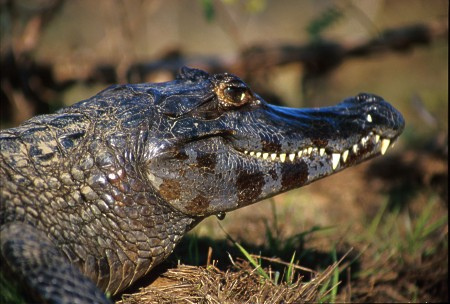
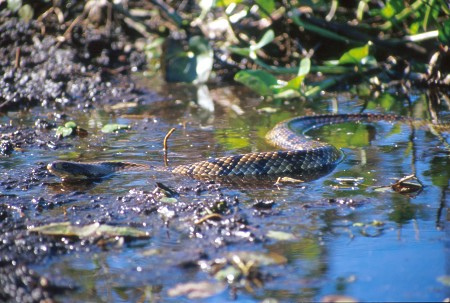
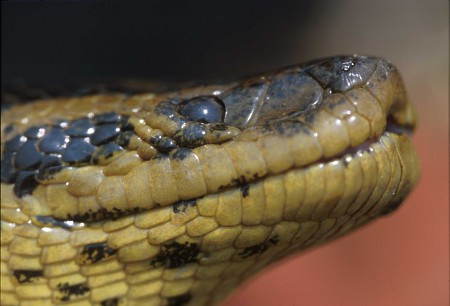


Banner image: Green Iguana (Wikimedia Commons/Ianaré Sévi).
Footer images: Jacaré; Anaconda; False Water Cobra (Andrew Mercer)
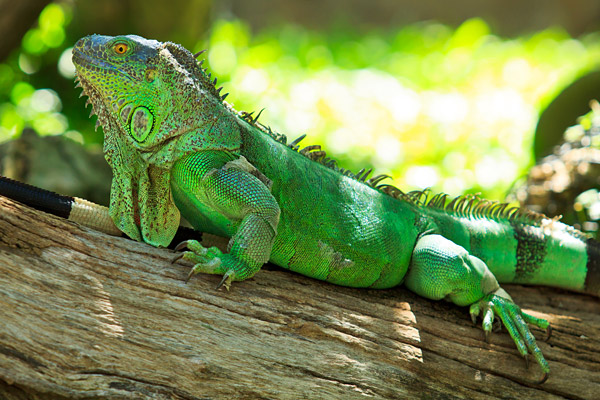
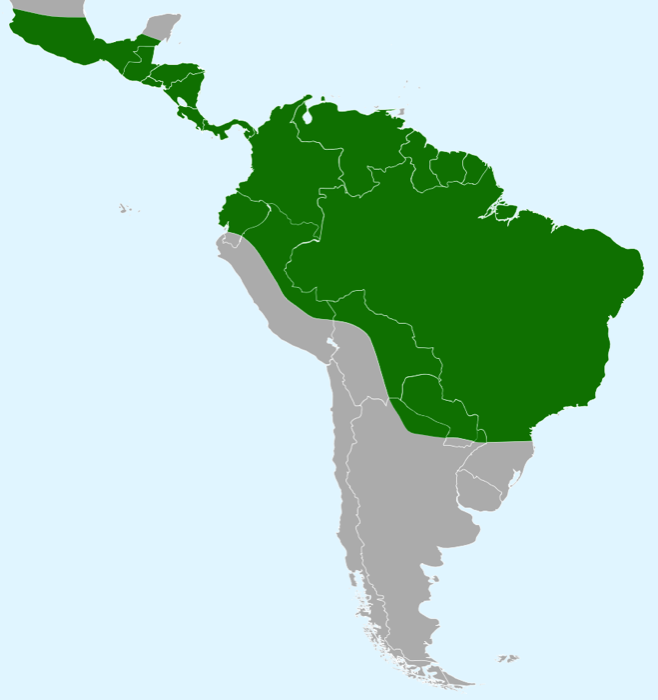
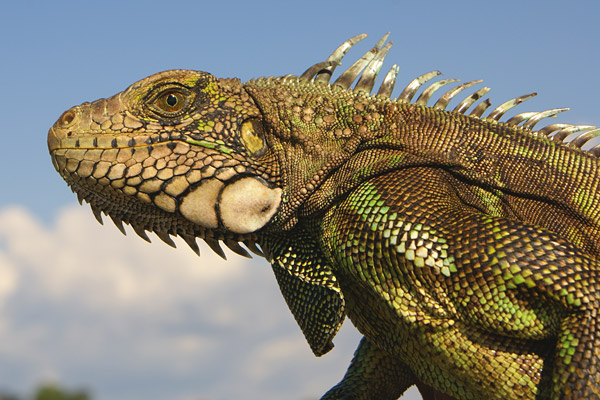
Pantanal Escapes